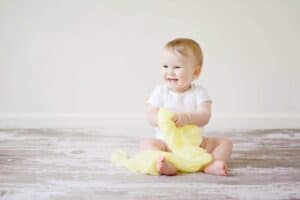Often, baby’s bottom suddenly becomes red and may even show open, bleeding or oozing areas: A sore bottom, also called diaper rash or diaper dermatitis, can affect any baby or diaper-wearing toddler. The inflammation of the diaper area, because that is all it is, can have many causes. In many cases, it occurs when diapering is too infrequent or there has been a change in baby’s daily routine. Typically, teething or sick children show such a rash. But a sore bottom can also occur as a result of the introduction of complementary feeding or – in the case of breastfed babies – when the mother has tried unfamiliar foods.
Table of contents
Miracle Buttocks In Babies? These Are The Symptoms
Doctors refer to the skin inflammation of the diaper area in babies and toddlers, popularly known as “sore bottom”, as diaper dermatitis.
Pediatricians and dermatologists distinguish between different degrees of severity, in which the following symptoms can occur individually or together:
- Reddening of the skin in the diaper area.
- Can occur over a wide area or in spots.
- Cracked and weeping skin.
- Bleeding skin.
- Scales.
- Whitish or yellowish blisters or pustules.
The latter two symptoms are less typical of diaper dermatitis, but a clear indication of a skin disease known as diaper thrush. In this case, yeast fungi settle on the inflamed skin.
Typically, sick children (e.g. as a result of a diarrheal illness or a respiratory tract infection) and babies treated with antibiotics are particularly susceptible to diaper thrush. The cause in this case is the weakened immune system, which can no longer defend itself effectively against fungi and bacteria.
Miracle Buttocks In Babies – When Do I Have To Take Them To The Pediatrician?
In principle, a reddened and slightly sore bottom in a baby is not a reason for a visit to the pediatrician, since you can also get the symptoms under control yourself with appropriate remedies. For this purpose, it makes sense to think intensively about the possible causes – such as a newly introduced food in older children or your diet as a breastfeeding mother – and to eliminate them if possible.
However, diaper dermatitis cannot always be treated with home remedies, which is why you should definitely consult your pediatrician if you experience these symptoms:
- The inflammation does not subside within three days despite treatment.
- Despite treatment, diaper dermatitis gets worse instead of better.
- Baby’s bottom has open and oozing, perhaps even bleeding, areas.
- Signs of diaper thrush, such as pustules, appear.
- The baby has diarrhea.
- The baby has a fever.
In case of diarrhea or fever, it is best to go to the doctor with your child immediately. Since children under the age of two in particular can quickly become dehydrated as a result of diarrhea, a watchful medical eye is always indicated. Fever should also always be monitored by a pediatrician for children in this age group – regardless of whether a sore bottom occurs in the baby or not.
Baby’s Sore Bottom – Common Causes Of Open And Weeping Areas In The Diaper Area
The fact that the skin in baby’s diaper area quickly becomes inflamed happens very quickly due to the moist and warm environment. Urine as well as the baby’s bowel movements additionally irritate the skin, as the excretions contain substances that promote inflammation, depending on their composition. The lack of air supply is also a common cause. For this reason, diaper dermatitis often develops when the baby was changed too infrequently – for example, because you could not immediately change a full diaper on the way.
As a result, your child’s skin was exposed to urine and bowel movements for too long. To avoid this, pediatricians recommend changing babies at least six times a day. In addition, diaper dermatitis occurs more frequently as soon as the usual environment in the diaper area changes, for example, due to changes in the child’s diet or due to an illness. Therefore, pay particular attention to suspicious symptoms in these circumstances:
- Your baby is suffering from diarrhea.
- Your baby is teething.
- Your baby is sick and has a cold, for example.
- Your baby is receiving an antibiotic as a result of an infection.
- Your baby is eating complementary food.
- Your baby has tried a new food.
- You are still breastfeeding and have eaten spicy or sour-tasting foods.
- You are using different diapers or different care products than usual.
- Your baby has been drinking juice or eating a lot of acidic fruit.
Basically, it can be summarized that due to medication or certain foods, the baby’s urine and stool become more acidic and thus attack the skin more quickly – the best conditions for the development of diaper dermatitis. However, if your child shows signs of skin inflammation after using a new brand of diapers or new care products, he or she is reacting to certain ingredients in these products. Therefore, make sure to stick with a brand that works, if possible. This should be free of fragrances and other artificial additives, as many children are hypersensitive or even allergic to these.
Breastfeeding Causes A Sore Bottom. Is That True?
In fact, breastfed babies are more prone to diaper rash than bottle-fed babies. Now you don’t have to stop breastfeeding right away because of this. The increased susceptibility is not due to breastfeeding itself, but mainly to what you eat or drink as a mother. So if your breastfeeding baby tends to get sores on the bottom frequently, you should avoid spicy, highly seasoned and very acidic foods and drinks.
These cause skin inflammations in fully breastfed children, as baby’s tummy cannot yet tolerate them. In particular, this concerns the following foods:
- Highly acidic fruits such as citrus fruits, but also strawberries.
- Fruit juices (especially orange juice).
- Sour pickled vegetables.
- Coffee.
But also other, unfamiliar foods – if the mother eats them in larger quantities, or carbonated drinks can cause irritation and redness in the diaper area. Fortunately, breastfeeding moms carry the cure for a sore bottom with them at all times: breast milk! A few drops of breast milk on the red bottom, dried in the air, often work wonders.
What To Do For Diaper Rash? How To Heal A Sore Bottom In A Baby Quickly
As soon as characteristic red spots appear in the diaper area and thus diaper dermatitis is present, quick help is important:
- Swaddle your child more often now, especially after meals and after each bowel movement.
- Allow your child to play for a longer period of time with bare bottom in the air.
- Fresh air against the skin is the best antidote, and most babies love the unaccustomed freedom of movement.
- To do this, lay your baby on a thick towel in a room that is as warm and draught-free as possible.
- Apply a thin layer of ointment containing zinc to the affected areas of the skin. You can get this over-the-counter at the pharmacy.
- Apply a very thin layer of cream so that air can get to the skin and the diaper remains absorbent.
- Pads dipped in chamomile tea or black tea, with which you dab the skin carefully, also help against the first redness. Then let the skin dry in the fresh air.
- Leave wet wipes out of the package and clean baby’s bottom with warm water and a soft washcloth instead.
- Do not rub stubborn dirt (it hurts your child now!), but remove it carefully with oil and a washcloth.
- Do not use soap for cleaning, as it also burns the skin and causes pain.
If all measures do not help, try a new diaper brand or new care products for the diaper area. Make sure that these do not contain fragrances and other unnecessary additives – these only irritate the skin unnecessarily. By the way, all home remedies are useless against diaper thrush, since the yeast fungus that causes it can only be eliminated with a fungicidal agent – so-called antimycotics. These can only be obtained from pharmacies on a pediatrician’s prescription. However, the basic recommendations regarding the care of the inflamed diaper area also apply in this case. In addition, pay more attention to hygiene and change towels, washcloths and changing pads after every diaper change – otherwise the diaper thrush will only disappear with difficulty, as the pathogen will be transmitted again and again.
What Is Healing Wool And Does It Really Help With A Sore Bottom?
Experienced midwives often recommend healing wool to treat baby’s sore bottom. This is untreated sheep’s wool that still contains a residual amount of lanolin. You can find this natural product in many drugstores and pharmacies, although you should look for organic quality when buying it. The application is very simple: Put some healing wool on the inflamed skin and wrap the child as usual. The wool then releases the lanolin it contains into the skin, where it has both a caring and anti-inflammatory effect. Alternatively, you can use a cream or lotion containing lanolin. Ointment and apply this thinly in the diaper area.
Caution: Too Much Care Also Causes Inflammation In The Diaper Area
By the way, not only too little, but also too much care causes diaper dermatitis and even diaper thrush. In particular, a buttocks that is always thickly creamed tends to become inflamed, as little air gets to the skin here. In addition, the cream layer prevents moisture from being absorbed by the diaper. Therefore, avoid prophylactic creaming and powdering of the diaper area. Instead, it is sufficient to keep the bottom clean and dry.
Caution, Danger To Life: Do Not Blow-Dry Baby’s Sore Bottom!
Some advice books or Internet forums contain the tip that a sore bottom can be dried painlessly with lukewarm air from a hairdryer. In fact, this advice is very dangerous, especially for little boys: if the baby suddenly pees while blow-drying and hits the hair dryer, he or she may suffer an electric shock. Therefore, it is better to take a dry, soft and clean towel with which you carefully dab the skin. However, do not rub the inflamed areas dry, as this will hurt your child. If you still do not want to do without the hair dryer, it is best to lay your child on his stomach.
Diaper Thrush – When A Fungus Is The Cause Of A Sore Bottom
Diaper thrush is caused by the yeast Candida albicans, which occurs naturally in the intestines and in the mouth and throat of healthy people. The pathogen only becomes problematic when the immune system is weakened for various reasons or the fungus settles on the already inflamed diaper area. Diaper thrush occurs more frequently in babies and toddlers because their immune systems are not yet fully developed and are therefore more susceptible. In addition, the warm, moist climate in the diaper area offers fungi the best conditions for growth. If your baby shows a red rash in the diaper area, possibly paired with coherent, whitish to yellowish pustules or blisters as well as scaly edges, it is most likely diaper thrush. However, only the pediatrician can make the diagnosis, especially since effective remedies are only available from pharmacies on a doctor’s prescription.
In addition to the buttocks, other parts of the body can also be affected, with Candida albicans often settling in the mouth. In this case, the disease is called oral thrush. Soft zinc ointments and antifungal agents (usually with the active ingredients clotrimazole or miconazole) help against diaper thrush, although the pediatrician may also prescribe hydrocortisone in severe cases.
In addition, strict hygiene measures are useful to prevent re-infection:
- Change diapers more often and let your baby romp with a bare bottom frequently.
- Use disposable diapers that are permeable to air without any additives.
- Boil cotton diapers after each use.
- Clean the baby’s bottom with a soft washcloth and lukewarm water.
- Dry the skin well afterwards.
- Now apply the ointments thinly.
- Change the pad, towel and washcloth after each diaper change.
- Wash your hands carefully after changing the diaper.
In addition, you can put your child in a bath enriched with chamomile, oat or wheat bran or oil, as this also works against the inflammation.
Appropriate bath additives (of course suitable for babies!) are available at the pharmacy.











2 thoughts on “Miracle Buttocks In The Baby: How To Recognize Skin Problems In The Diaper Area”